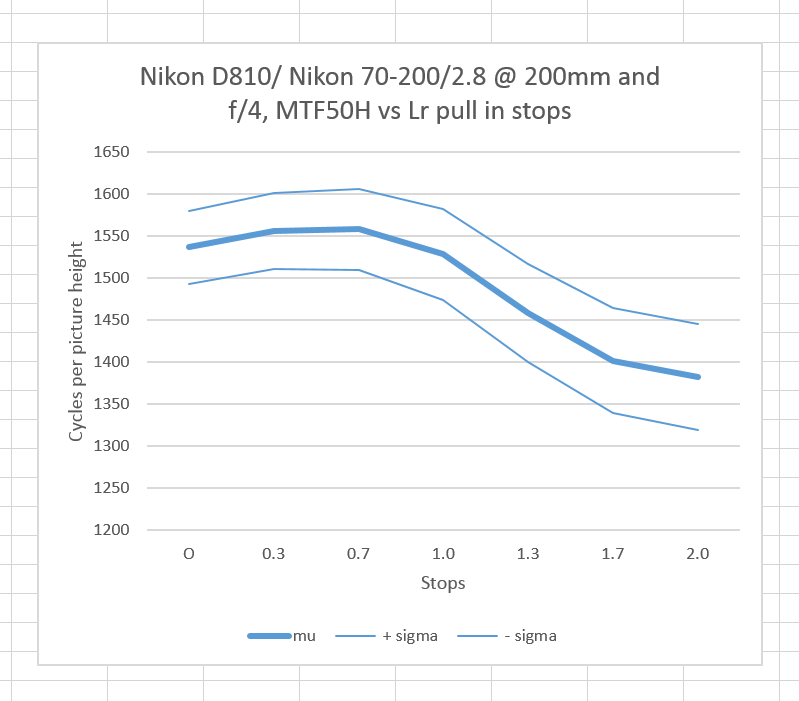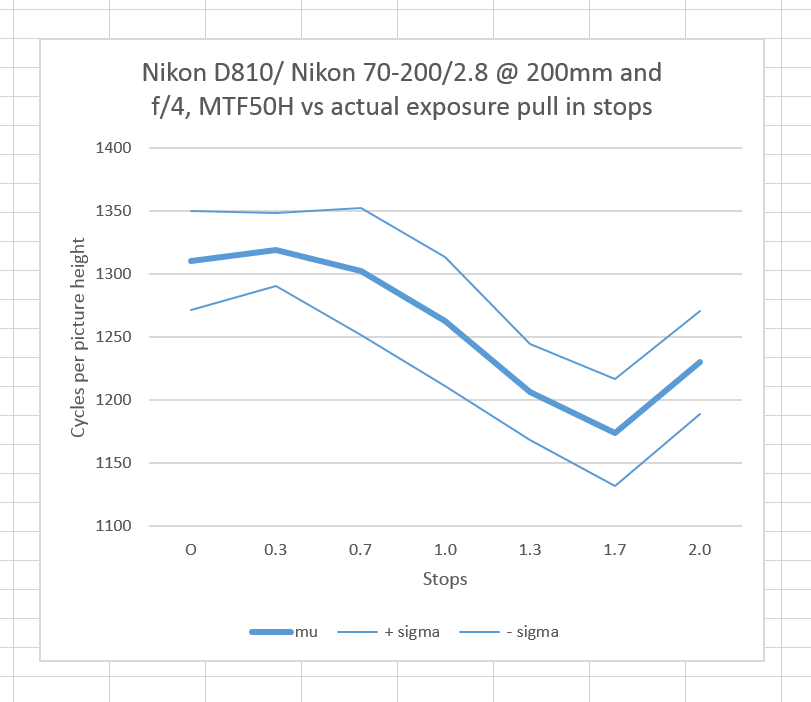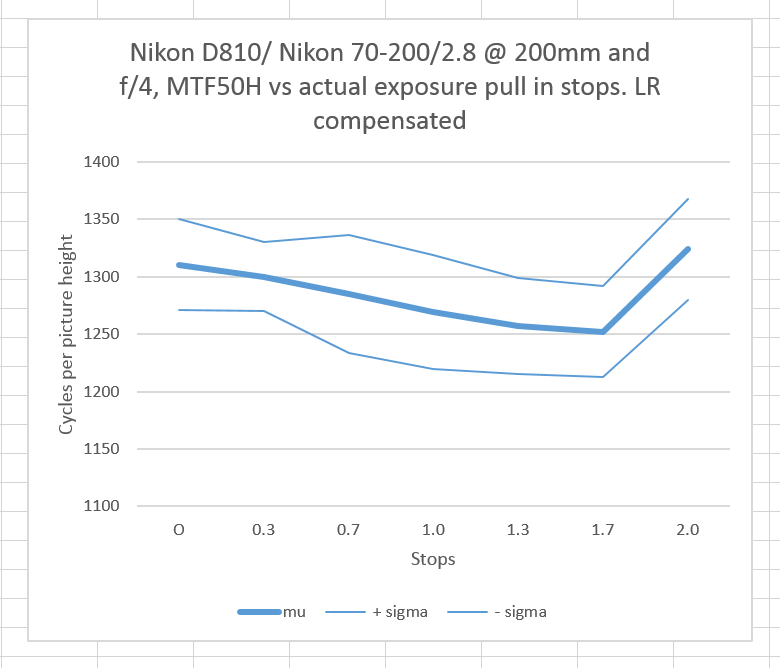I’ve been reporting on the modulation transfer function results from some lens/sensor testing that I’ve been doing. I few days ago, I show you some work that I’d done with the Nikon 70-200 f/2.8 GII ED on the Nikon D810 to the Sony 70-200 f/4 G OSS FE on a Sony a7RII. I’ve been having some problems getting repeatable results, and I’ve started looking at the things that could impair repeatability.
Today I want to deal with exposure, both actual photons-hitting-the-sensor exposure and the Lightroom Exposure control.
I took one set of sixteen exposures of the Imatest slanted-edge target made with the Nikkor zoom set to 200 mm and f/4, and attached to the D810. Details: ISO 100, target centered, EFCS on, 5500 K LED illumination, autofocus on a Siemens star, release by intervalometer, developed in Lr with default settings except for white balance on the paper white.
Then I did a series of Exposure pulls in Lr, of the whole set, in 1/3 stop increments from zero to 2 stops, exported them to Imatest, measured the MTF50 using the horizontal edge nearest the focusing point, and plotted the results:
There is quite a large effect on the MTF. Hmm…
I next ran a series of 16-exposure sets where the actual in-camera exposure was reduced by decreasing the shutter speed in 1/3 stop steps over the same range:
I’m not sure what that jump at the end is all about, but it looks like roughly the same effect occurs with real as well as development pulls.
The obvious question is, “Can we compensate for actual exposure differences with Lightroom development?” Applying successive pushes in Lr in the amount of the pulls in exposure to the above sequence gives us the answer:
It looks like, to some extent, that post processing pushes (and, I assume, pulls) can largely compensate for uneven target illumination and exposure differences.
This has implication for measuring center and corner sharpness in the presence of lens falloff.



Jack Hogan says
Hi Jim,
Great topic of study, of great interest (to me:-). In my limited experience the problem is the relationship between noise and contrast (posterization like). Given the small change in exposure of your tests (2 stops) and taking technique out of the equation, I think either the chart, the measuring program or the converter are letting you down.
Below a certain exposure/contrast threshold fewer photons result in a larger standard deviation of the results because the MTF curve starts bending left and right, becoming inconsistent from capture to capture. However, if not taken to an extreme, the mean over several identical captures should more or less stay the same as exposure is changed. In other words if you take 16 identical ‘noisy’ captures and plot their MTF50 values as you did above I would expect a relatively wavy mean line with a relatively wide standard deviation. If you stack the 16 and remeasure, I would expect a much straighter mean line threading through the earlier wave, with a tighter standard deviation.
As you know I often use MTFMapper to measure MTF50 values off the slanted edges in DPR studio scene raw captures at various ISOs, representing exposure differences much beyond two stops. For FF raw files captured with good technique in DPR’s exposure range, MTF50 values are usually pretty steady between base and ISO 800 or 1600, with exposure varying 3-4 stops. That’s with a single capture at each exposure. I’ve sent you a couple of examples via email.
So the bendy curves you show above could be due to, for instance, too low a contrast chart for the noise; Imatest not being up to the task with noisier images; and LR amplifying the noise or performing some of its usual settings-related subliminal tweaking.
I am quite interested to see if you on the other hand find some other factor that I don’t know about.
Jack
Jim says
Jack, I don’t think the exposure sensitivity is just an SNR issue, because I’ve observed ISO insensitivity in the past and Lr pushing is so effective at removing most of the effect. I should probably do the same thing with raw green channels and see what happens. I double checked the gamma settings in Imatest and they’re right (0.45, is the way they say it).
I do use a low contrast (4:1) target, as recommended by Imatest.
Lots to check out here.
Maybe I ought to take one of the Imatest two-day seminars. I couldn’t imagine before I started doing this series of tests that there’s two days of discussion to be had on SFR testing, but maybe I was wrong. I wonder if it’s worth getting on an airplane for, though.
Jim